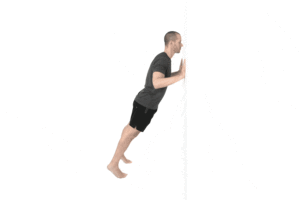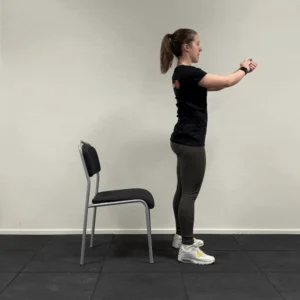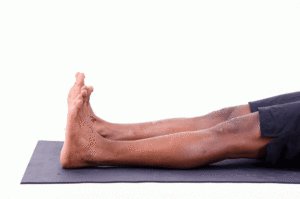Strength Training Exercises for Joint Support
Building muscle around your joints is essential for reducing rheumatoid arthritis pain and improving joint stability. Here are some gentle strength exercises with simple steps to help you get started:
Wall Push-Ups
- Stand facing a wall, about an arm’s length away.
- Place your hands flat on the wall at shoulder height.
- Slowly bend your elbows, bringing your chest closer to the wall.
- Push back to the starting position.
- Repeat 8–12 times.

Resistance Band Exercises
- Hold a light resistance band with both hands or loop it around your legs.
- Perform gentle pulls or leg presses, focusing on controlled movements.
- For example, stretch the band by opening your arms or pushing your knees apart.
- Repeat 10–15 times.
Leg Lifts
- Sit or lie down with one leg straight and the other bent.
- Slowly lift the straight leg a few inches off the floor.
- Hold for a few seconds, then lower it down slowly.
- Repeat 10–15 times on each leg.

Bicep Curls with Light Weights
- Hold light weights or water bottles in each hand.
- Keep your elbows close to your sides and slowly curl your hands toward your shoulders.
- Lower slowly back down.
- Repeat 8–12 times.

Chair Squats
- Stand in front of a sturdy chair with feet shoulder-width apart.
- Slowly lower your body as if you’re going to sit down, stopping just before you touch the chair.
- Push through your heels to stand back up.
- Repeat 8–12 times.

Ankle Pumps
- Sit comfortably with your feet flat on the floor.
- Lift your toes while keeping your heels on the ground, then lower them.
- Next, lift your heels while keeping toes on the ground.
- Repeat this pumping motion 15–20 times.

These simple exercises help strengthen muscles around your joints, reducing strain and pain while improving your overall mobility and balance. Start slowly, listen to your body, and gradually increase repetitions as you get stronger.
Flexibility and Stretching Exercises

Keeping your joints flexible is key to managing rheumatoid arthritis pain and maintaining your range of motion. Gentle stretching helps reduce stiffness, improve circulation, and make daily movements easier. Here are some simple flexibility exercises you can try:
Neck Stretch
- Sit or stand tall.
- Slowly tilt your head toward one shoulder until you feel a gentle stretch.
- Hold for 15–20 seconds, then switch sides.
Shoulder Rolls
- Sit or stand with your back straight.
- Roll your shoulders forward slowly in a circular motion 10 times.
- Then roll them backward 10 times.
Wrist Stretch
- Extend one arm in front, palm facing down.
- Use your other hand to gently pull your fingers downward toward the floor.
- Hold for 15–20 seconds, then switch hands.
Finger Stretch
- Spread your fingers wide apart, hold for 5 seconds.
- Then slowly make a fist and release.
- Repeat 10 times.
Hamstring Stretch
- Sit on the floor with one leg extended straight and the other bent.
- Reach gently toward your toes of the extended leg until you feel a stretch in the back of your thigh.
- Hold for 20 seconds, then switch legs.
Ankle Circles
- Sit comfortably and lift one foot off the ground.
- Slowly rotate your ankle in circles 10 times clockwise, then 10 times counterclockwise.
- Switch ankles.
Regular stretching can help keep your joints supple and reduce the tightness that comes with arthritis. Remember to stretch slowly and avoid pushing into pain. Adding these simple stretches to your daily routine can improve flexibility and ease arthritis discomfort.
Tips for Exercising Safely with Rheumatoid Arthritis
Here are some easy tips to help you exercise safely:
- Start Slow: Begin with gentle exercises and low intensity. Gradually increase the duration and intensity as your body gets used to it.
- Warm Up and Cool Down: Always warm up your muscles with light movements before exercising and cool down afterward with gentle stretches to prevent stiffness.
- Listen to Your Body: If you feel sharp pain, swelling, or discomfort during exercise, stop and rest. It’s okay to take breaks or modify exercises as needed.
- Choose Low-Impact Activities: Focus on exercises that are easy on the joints, like swimming, walking, or cycling, to reduce stress on your body.
- Use Proper Equipment: Wear supportive shoes and use any recommended braces or supports to protect your joints during activity.
- Stay Hydrated: Drink plenty of water before, during, and after exercise to keep your body well-hydrated.
- Work with Professionals: If possible, consult a physical therapist or fitness trainer experienced in arthritis care to create a safe, effective exercise plan tailored to your needs.
By following these tips, you can enjoy the benefits of exercise while keeping your joints safe and healthy. Remember, consistency is key — even small daily movements make a difference!
What Diet is Best for Rheumatoid Arthritis?
 Apart from exercises, diet plays a crucial role in managing rheumatoid arthritis (RA) symptoms. The right foods can help reduce inflammation, improve joint function, and even ease pain. Here’s how the right diet can support your arthritis treatment:
Apart from exercises, diet plays a crucial role in managing rheumatoid arthritis (RA) symptoms. The right foods can help reduce inflammation, improve joint function, and even ease pain. Here’s how the right diet can support your arthritis treatment:
-
Anti-Inflammatory Foods:
Focus on foods that fight inflammation, such as fatty fish (salmon, mackerel, sardines), olive oil, nuts, and seeds. These are rich in omega-3 fatty acids, which help reduce joint swelling.
-
Fruits and Vegetables:
Leafy greens, berries, and citrus fruits are loaded with vitamins, antioxidants, and minerals that support your immune system and help fight oxidative stress, which is linked to inflammation.
-
Whole Grains:
Whole grains like brown rice, quinoa, and whole wheat are packed with fiber, which may help reduce inflammation and improve overall digestive health.
-
Lean Proteins:
Incorporate chicken, turkey, and plant-based proteins like tofu and lentils to promote muscle health and repair joint tissues without adding excess fat.
-
Spices and Herbs:
Turmeric and ginger are well-known for their anti-inflammatory properties. Adding them to your meals can help reduce inflammation and pain naturally.
-
Avoid Processed Foods and Sugars:
Steer clear of processed foods, fried items, and sugary snacks, which can trigger inflammation and worsen arthritis symptoms. Opt for fresh, whole foods instead.
-
Vitamin D and Calcium:
Including foods like leafy greens, fortified dairy, and fish helps strengthen bones and joints, which is important if you’re at risk for osteoporosis due to RA.
By combining exercise with a balanced, anti-inflammatory diet, you’ll be taking a holistic approach to managing your rheumatoid arthritis and improving your quality of life. Don’t forget to consult with your doctor or a nutritionist to tailor your diet to your personal needs!
Get Guidance from an Online Orthopedician
Are you struggling with joint pain, stiffness, or other symptoms of rheumatoid arthritis? Finding the right treatment and advice can be overwhelming, but you don’t have to face it alone.
If you’re looking for expert guidance to manage your arthritis effectively, MantraDoc is here to help. On our platform, you can get matched with a qualified online orthopedician who understands your specific needs and can provide personalized care — all from the comfort of your home.
Don’t wait for the pain to worsen. Take the first step toward better joint health today.
Click the button below to consult an online arthritis expert and start your journey to relief!
Consult Online Orthopedic Specialist









 Apart from exercises, diet plays a crucial role in managing rheumatoid arthritis (RA) symptoms. The right foods can help reduce inflammation, improve joint function, and even ease pain. Here’s how the right diet can support your arthritis treatment:
Apart from exercises, diet plays a crucial role in managing rheumatoid arthritis (RA) symptoms. The right foods can help reduce inflammation, improve joint function, and even ease pain. Here’s how the right diet can support your arthritis treatment: